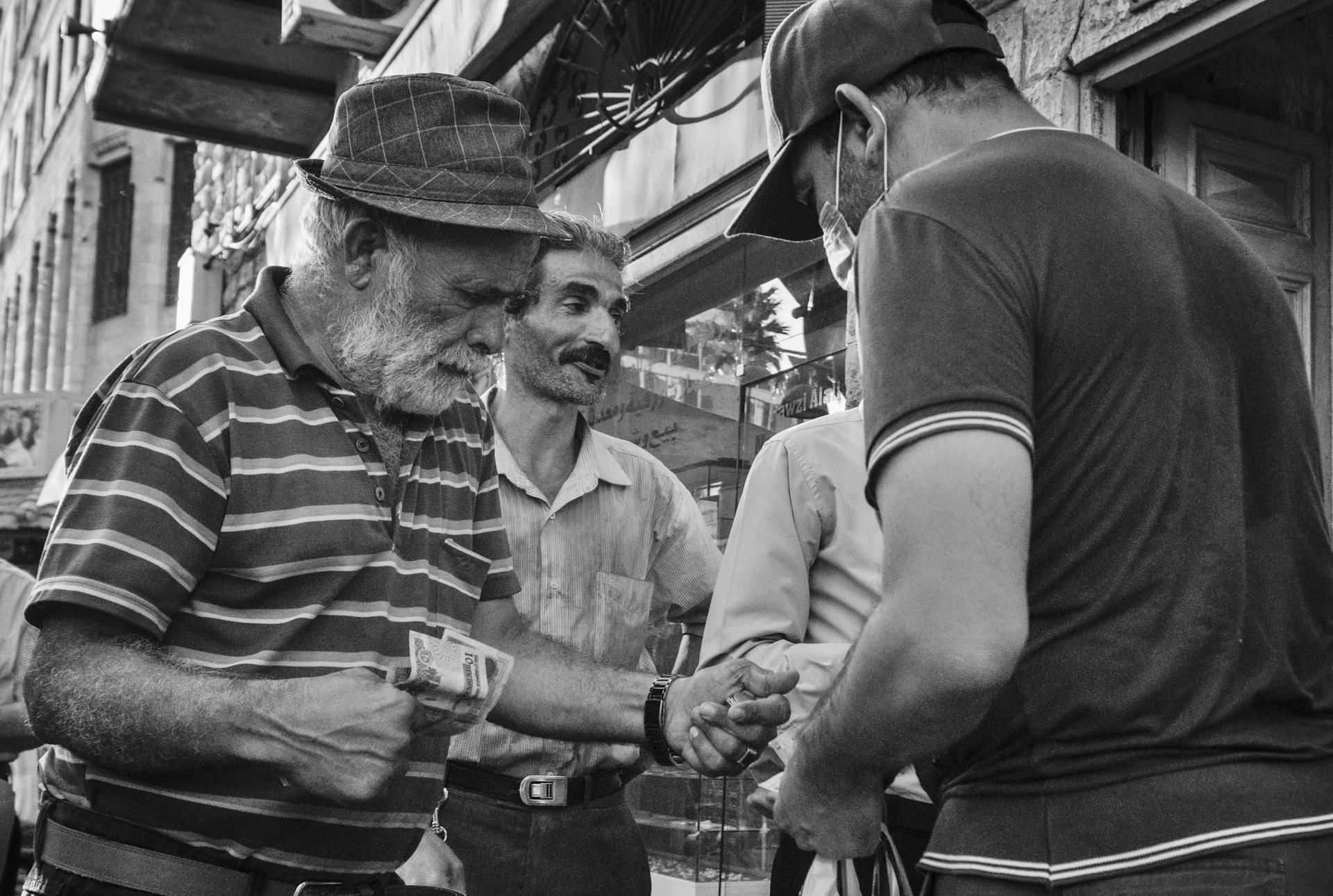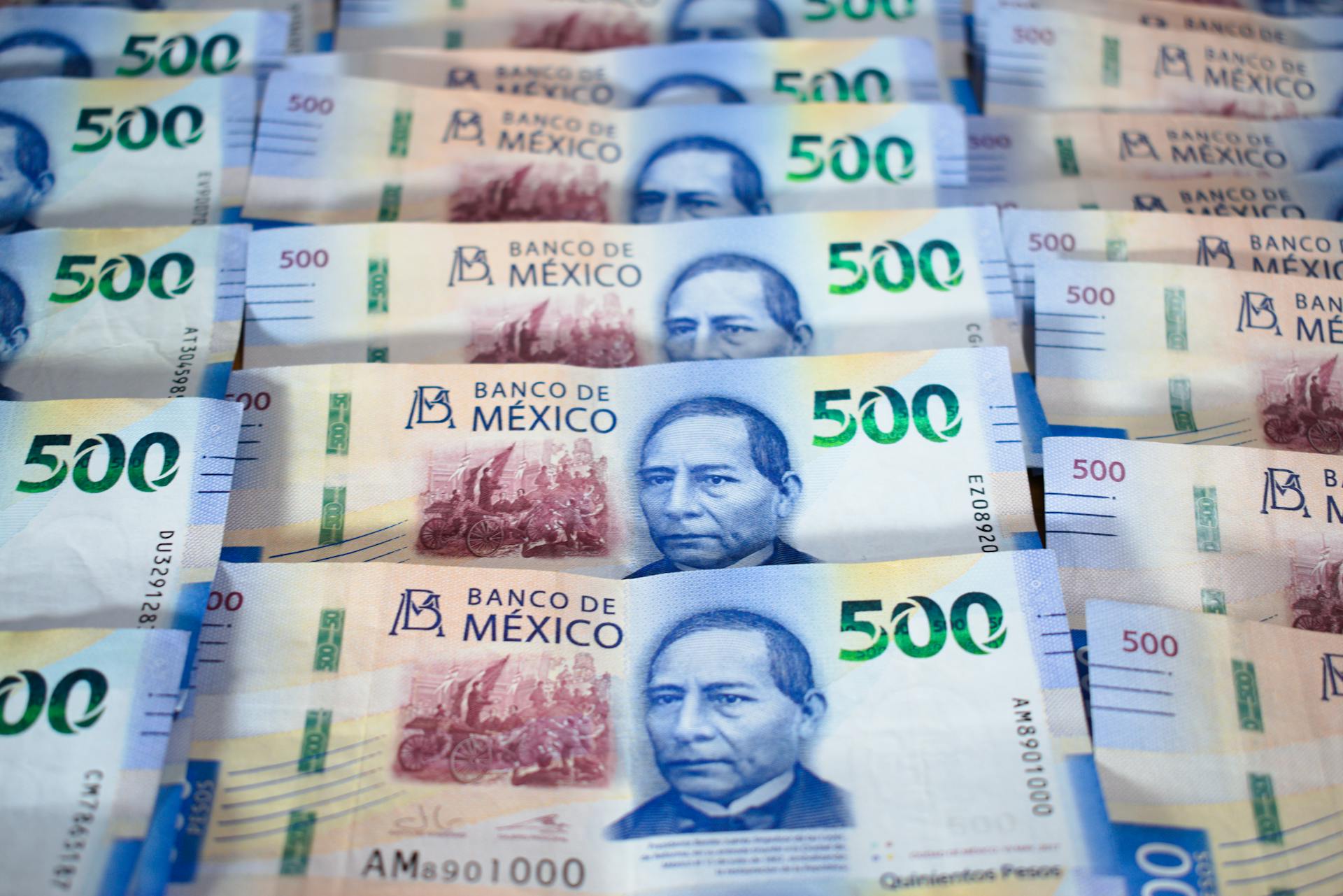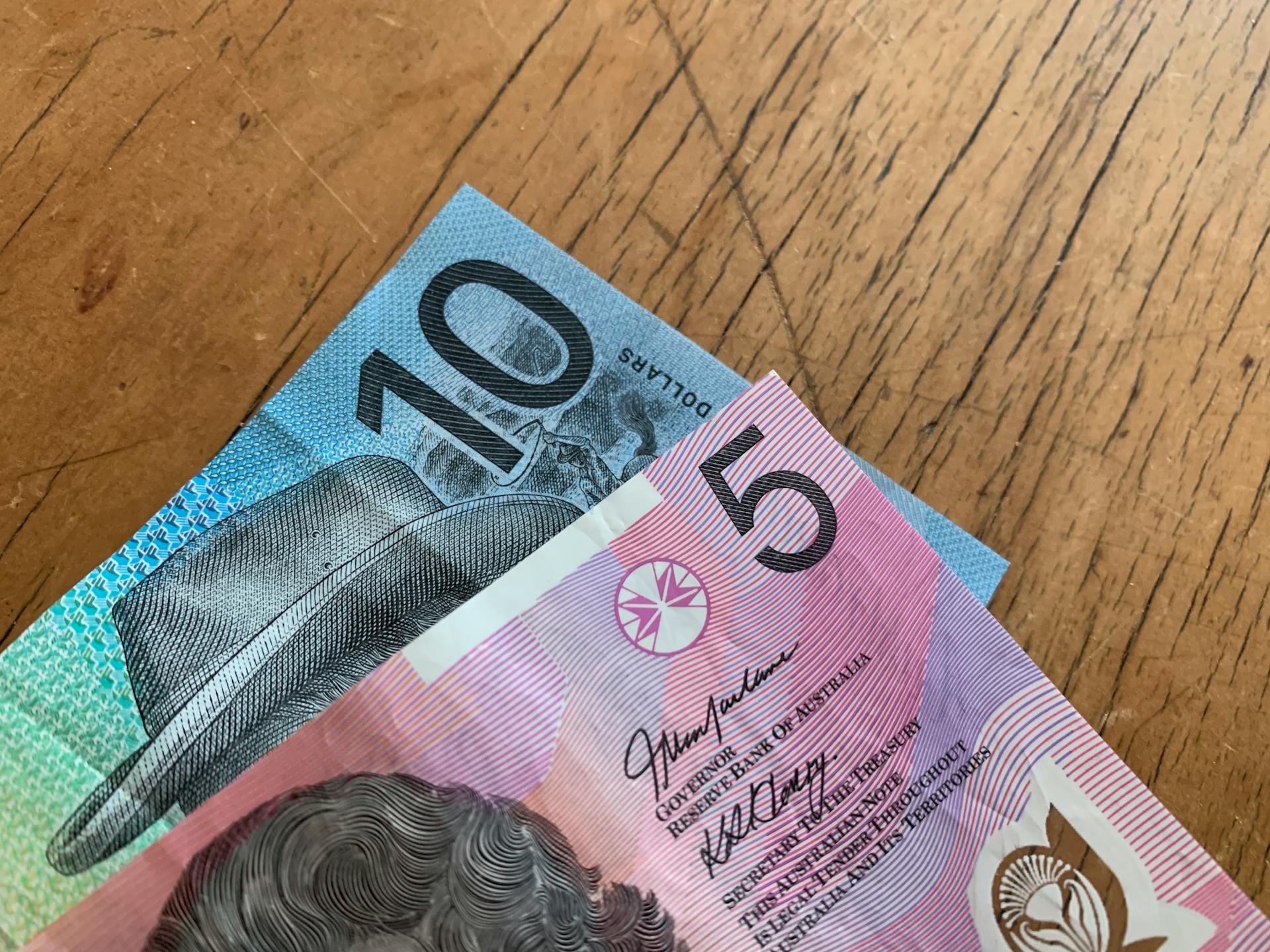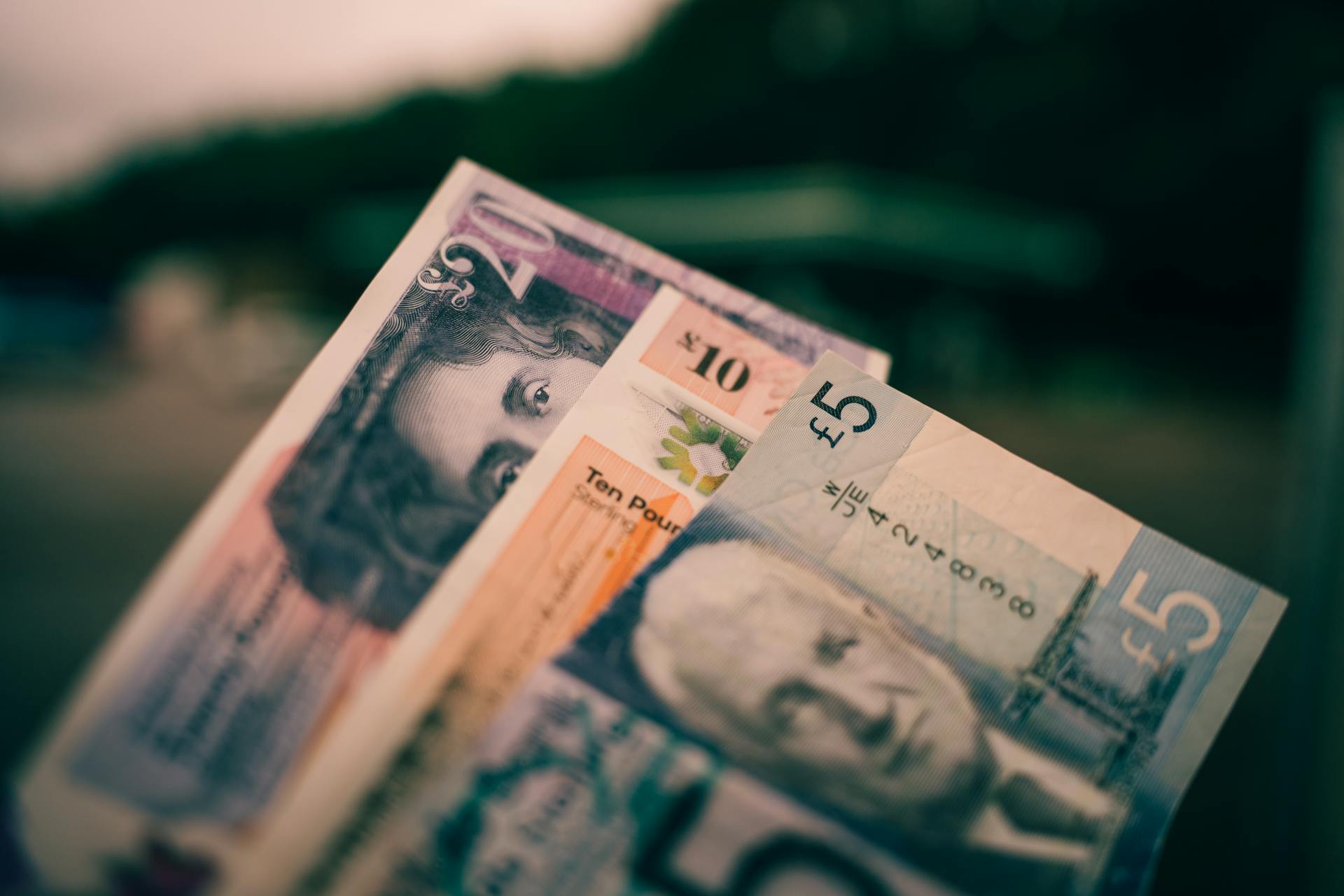
The Saudi Riyal, commonly abbreviated as SAR, is the official currency of Saudi Arabia. It's widely accepted and used throughout the country.
The SAR is pegged to the US dollar, with a fixed exchange rate of 1 USD = 3.75 SAR. This peg helps maintain the currency's value and stability.
The SAR is divided into 100 halalas, which are the currency's subunits. You'll often see prices displayed in both SAR and halalas, especially in smaller transactions.
In Saudi Arabia, you can easily exchange your currency for SAR at banks, currency exchange offices, or even some hotels and airports.
For your interest: Currency Exchange in Saudi Arabia
History of Saudi Riyal
The Saudi Riyal has a rich history that dates back to 1932, when Saudi Arabia was established, and the Riyal was introduced as the country's currency.
Initially, 1 riyal was equal to 22 qurush coins, but this was later amended to 20 qurush coins equating to 1 riyal by 1960.
The Saudi Arabian Monetary Agency (SAMA) was formed in 1952, ushering in multiple reforms aimed at establishing a unified currency system.
Discover more: Series B Banknotes
In 1963, the currency was decimalized, and a new subunit called the halala was introduced, dividing the riyal into 100 equal parts.
The Riyal was officially pegged to the IMF's special drawing rights (SDRs) in June 1986, effectively fixing its value at 1 U.S. dollar = 3.75 riyals.
The Riyal experienced a brief surge to a 20-year high post the US Federal Reserve's interest rate cut in September 2007, but it eventually returned to its peg against the U.S. dollar in early December 2007.
The first Saudi metal currency was minted by King Abdulaziz in 1925, featuring copper coins for the denominations of a quarter Qirsh and half Qirsh.
The first Saudi paper currency was issued in 1961, with denominations of SAR100, SAR50, SAR10, SAR5, and SAR1, and was withdrawn from the markets 10 years later in 1971.
Take a look at this: Which Country Does Not Use Euro as Its Currency
Exchange Rates
The Saudi riyal, abbreviated as SAR, is a widely used currency in Saudi Arabia. It's divided into 100 halalas, with the smallest denomination being 1 halala.
The SAR exchange rate with the US dollar (USD) is 3.75 USD to SAR. This fixed exchange rate has been in place since 1986.
To give you a better idea of the SAR exchange rate, here's a table showing the exchange rates for SAR against various currencies:
The SAR exchange rate can fluctuate, but it's essential to be aware of the current rate when traveling or conducting international transactions.
Saudi Riyal Issuance
The Saudi Riyal issuance has a rich history, with the first metal currency being minted in 1925 by King Abdulaziz, featuring copper coins with the Hijri date of minting and the place of minting (Umm al-Qura) on the back side.
The first Saudi paper currency was issued in 1961 during the reign of King Saud Bin Abdulaziz Al Saud, in denominations of SAR100, SAR50, SAR10, SAR5, and SAR1.
The first paper currency featured the name "Saudi Arabian Monetary Agency" along with the date and number of the Royal Decree under which it was issued on the front side.
For more insights, see: Nigerian Security Printing and Minting Company Limited
The SAR1 denomination was issued in maroon, with an image of Jabal an-Nour in Makkah al-Mukarramah at the center, while the SAR5 denomination was printed in blue and featured an image of al-Masmak Palace in Riyadh City.
The sixth issuance of the Saudi currency, launched in 2016, included thirteen coin and banknote denominations designed according to global techniques and standards that consider technical and security specifications.
The sixth issuance featured the slogan "Trust and Security" and included denominations such as SAR500, SAR100, SAR50, SAR10, and SAR5 for paper currencies, and SAR2, SAR1, fifty halalas, twenty-five halalas, ten halalas, five halalas, and one halala for coin denominations.
The sixth issuance also introduced a SAR5 denomination made of polymer in 2020, with colors and designs similar to the cotton-based version, but with differences in manufacturing techniques and security features.
A different take: Costa Rican Colón Coins and Banknotes
Saudi Riyal Currency
The Saudi Riyal currency has undergone significant changes over the years, with six issuances of paper currency since its introduction. The first official paper currency issue was issued in 1961, featuring denominations of SAR100, SAR50, SAR10, SAR5, and SAR1.
Suggestion: Japanese Yen Paper Money
Each denomination had a unique design, with the SAR1 note featuring an image of Jabal an-Nour in Makkah al-Mukarramah, and the SAR5 note featuring an image of al-Masmak Palace in Riyadh City. The SAR10 note, on the other hand, showcased a depiction of the port of Jeddah.
The SAR500 banknote, introduced in the sixth issuance, represents the highest value and features a portrait of the Founder King Abdulaziz Bin Abdulrahman Al Saud and the Kaaba on the front.
Paper Currencies (Banknotes)
The SAR500 banknote represents the highest value in the sixth issuance of Saudi banknotes, featuring a portrait of King Abdulaziz Bin Abdulrahman Al Saud and the Kaaba on the front.
The SAR500 banknote is predominantly colored in blue, with a view of the Grand Mosque in Makkah al-Mukarramah on the reverse side. This is a significant design element, as the Grand Mosque is one of the most sacred sites in Islam.
The SAR200 denomination features a portrait of King Abdulaziz on the front, along with the three-dimensional logo of Saudi Vision 2030. This logo is a prominent symbol of the country's modernization efforts.
The SAR100 banknote features a portrait of King Salman Bin Abdulaziz Al Saud and the Green Dome of the Prophet's Mosque on the front, while the reverse depicts a view of the Prophet's Mosque in al-Madinah al-Munawwarah. The banknote is predominantly in red.
The SAR50 banknote is mostly in green, with a similar front design to the SAR100, showing King Salman's portrait alongside the Dome of the Rock Mosque. On the reverse, there is an image of al-Aqsa Mosque in Palestine.
The SAR10 banknote features a portrait of King Salman on the front, along with a view of al-Marabba Palace in Riyadh City. The reverse shows an image of the King Abdullah Financial Center in Riyadh, in a brown color.
The SAR5 banknote features an image of King Salman alongside the view of the Shaiba field situated in the Empty Quarter desert, with a depiction of wildflowers in the background. This banknote features a purple hue.
Coins
The Saudi currency has a total of seven coin denominations. These coins were introduced as part of the sixth issuance of the Saudi currency.
The SAR2 coin is the highest valued coin, featuring a golden center and a silver frame. It showcases a portrait of King Abdulaziz on the obverse side.
The SAR2 coin also features the numerical denomination at the center, the written denomination above it, and the English denomination below on the reverse side. A silver frame encircles the design.
The SAR1 coin matches the SAR2 coin in shape, front and back, with the front featuring a portrait of King Salman. The edges are framed in gold.
The fifty halalas coin features a singular color scheme predominating, with the national emblem at its center. The inscription 'Custodian of the Two Holy Mosques' is displayed above the emblem.
The fifty halalas coin also features the numeral (50) at its core on the reverse side, flanked by the Arabic inscription 'fifty halalas' above and its English counterpart below. Adorned with floral motifs at the upper and lower edges.
You might enjoy: 1899 United States Five-dollar Silver Certificate
The ten-halalas denomination coin is predominantly made of silver, featuring the Kingdom's emblem at its center. At the top is the title 'Custodian of the Two Holy Mosques'.
The ten-halalas coin showcases a floral decoration surrounding the emblem, with the name of King Salman Bin Abdulaziz engraved at the bottom.
Commemorative Currencies
The Saudi Arabian Monetary Agency, now known as the Saudi Central Bank, has released several commemorative banknote editions to mark special occasions. One notable example is the SAR200 and SAR20 banknotes issued in January 1999 to commemorate the hundredth anniversary of the establishment of the Kingdom.
The SAR200 banknote features a portrait of King Abdulaziz at its center, accompanied by an image of al-Masmak Palace in Riyadh City on the right side. The name of the Saudi Arabian Monetary Agency encircles the repeated state logo at the center.
The SAR20 banknote showcases a portrait of King Abdulaziz in the center, with an image of the Quba Mosque in al-Madinah al-Munawwarah to the right. The name SAMA is written above the mosque image.
Intriguing read: Qatar Currency Name
Another SAR 20 banknote was issued to commemorate the Kingdom's presidency of the Group of Twenty (G20). This note features a portrait of King Salman Bin Abdulaziz Al Saud, as well as the three-dimensional printed logo of the Kingdom's G20 presidency.
The reverse side of the G20 commemorative note displays a world map highlighting the Kingdom's geographical location with a ray symbolizing the convergence of G20 nations on its soil.
Broaden your view: Hashemite Kingdom of Jordan Currency
Frequently Asked Questions
What is Riyal short?
The Riyal is the basic unit of money for Qatar and Saudi Arabia, represented by a bill worth one unit. It's often abbreviated as RYAL or RLS.
Featured Images: pexels.com


